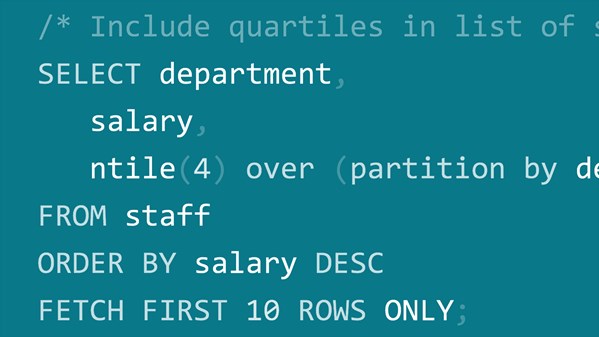
SQL Server is the database used with Azure and many on-premises environments and is quickly becoming a very popular RDBMS. Get an overview of installing, administering, and managing SQL Server 2016 in this course with SQL Server expert Gerry O'Brien.
Learn how to install the database and tools, configure different instances, optimize performance, and secure your database with user roles and logins. Gerry also covers administrative duties such as backup and restoration, database migration, and
high-availability options, including database replication, log shipping, and always-on availability.
This course is also ideal for anybody preparing for the Administering a SQL Database Infrastructure (70-764) exam, one of two exams necessary
to earn an MCSA: SQL 2016 Database Administration certification.

SQL Server comes with many features for monitoring, securing, optimizing, and supporting your database infrastructure. Learn how to use these features to administer your SQL Server instances, and prepare for the Microsoft MCSA Administering a SQL Database Infrastructure (70-764) certification exam.
Adam Wilbert covers four main skill areas required of SQL Server 2016 administrators: configuring access to data, managing backups, monitoring performance, and implementing the high-availability features of the product. Learn about data encryption, access control, role-level security, and dynamic data masking. Use SQL Server auditing to gain insights into the health and performance of your system, and determine upgrade paths. Discover how to back up SQL Server and perform full or partial restores, and monitor activity. Explore indexing and query execution plan management. Plus, learn to configure availability groups to mitigate hardware failure.

Mastering SQL is an essential skill for any Oracle professional and the first step in becoming a true Oracle expert. In this course, Bob Bryla covers the basics required to code using SQL in an Oracle 19c Database environment. Bob covers what you need to know to get data in and out of your database tables, as well as how to modify data. He explains how to leverage SELECT statements, filter and sort rows, use both single- and multiple-row functions, and join tables. He delves into the Oracle data dictionary—a set of tables that provide information about a database—and shows how to query it. Plus, he demonstrates how to efficiently delete data using DML statements. Upon wrapping up this course, you'll have the fundamental skills you need to work with SQL in this popular relational database management system.

Master the fundamentals of SQL Server 2019, the industry-leading database management platform from Microsoft. In this course, instructor Adam Wilbert equips beginners with the core skills they need to create and manage SQL Server databases. Adam begins with the basics, showing how to install SQL Server and log into a local database server. He then discusses how to create new databases, design tables, define relationships, write queries, and use stored procedures and built-in functions. Plus, he demonstrates how to perform crucial database administration tasks, such as backups and restores, security enhancements, and performance monitoring.

Get Ben Sullins's 12 must-have SQL techniques for data science pros—engineers, DevOps, data miners, programmers, and other systems specialists. Ben's tips focus on practical applications of SQL queries for data analysis. Learn how to retrieve data, join tables, calculate rolling averages and rankings, work with dates and times, use window functions, aggregate and filter data, and much more. Each tip is short, relevant, and up to date with current industry best practices—making this the perfect course for busy analysts who normally struggle to find time to build their skills.

SQL queries can be fast and highly efficient, but they can also be slow and demand excessive CPU and memory resources. For many SQL programmers, occasional bouts with long-running queries and poor performance are simply par for the course. But by gaining a better understanding of how databases translate SQL queries into execution plans, you can take steps to avoid these issues. In this course, Dan Sullivan shows developers how to analyze query execution plans and use data modeling strategies to boost query performance. Dan describes how SQL queries are executed; highlights different types of indexes and how they factor in query tuning; covers several methods for performing joins; and discusses how to use partitioning and materialized views to improve performance.

Never worked with a database before? In this course, Adam Wilbert goes over the most important features of working with SQL Server 2019, providing brand-new users with a first look at how the server operates. Instructor Adam Wilbert introduces the main working environment, SQL Server Management Studio, and walks you through how to create tables, define relationships, and write and run queries with Transact-SQL commands. Upon wrapping up this course, you’ll know everything you need to accomplish to create your first database. Start watching to quickly get up and running with this professional-grade database management system.

The course begins with a brief overview of SQL. Then the five major topics a data scientist should understand when working with relational databases: basic statistics in SQL, data preparation in SQL, advanced filtering and data aggregation, window functions, and preparing data for use with analytics tools.
Topics include:
- Data manipulation
- ANSI standards
- SQL and variations
- Statistical functions in SQL
- String, numeric, and regular expression functions in SQL
- Advanced filtering techniques
- Advanced aggregation techniques
- Windowing functions for working with ordered data sets
